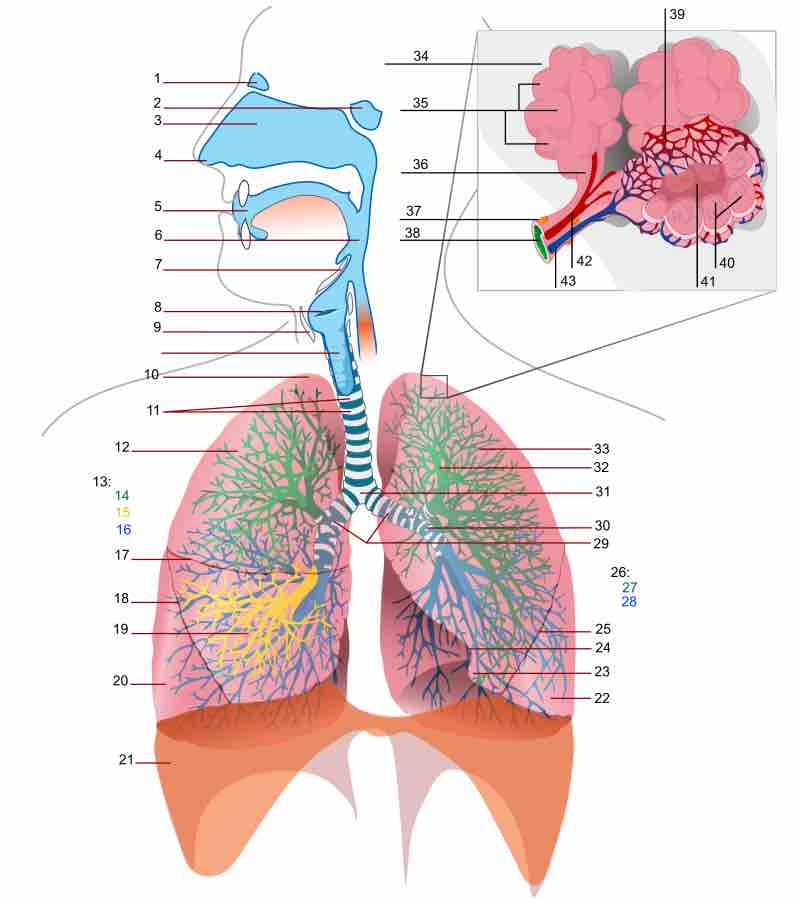A bronchus (plural bronchi, adjective bronchial) is a passage of airway in the respiratory tract that conducts air into the lungs. The bronchus branches into smaller tubes called bronchioles.
The bronchi and bronchioles are considered anatomical dead space, like the trachea and upper respiratory tract, because no gas exchange takes place within this zone.
Anatomy of the Bronchi
The human trachea divides into two main bronchi (also called mainstem bronchi), that extend laterally (but not symmetrically) into the left and right lung respectively, at the level of the sternum. The point where the trachea divides into the bronchi is called the carina.
The right main bronchus is wider, shorter than the left main bronchus, which is thinner and longer. The right main bronchus subdivides into three lobar bronchi, while the left main bronchus divides into two. The lobar bronchi (also called secondary bronchi) divide into tertiary bronchi, each of which supplies air to a different bronchopulmonary segment.
A bronchopulmonary segment is a distinct region of the lung separated from the rest of the lung by connective tissue. Each bronchopulmonary segment forms a discrete functional unit in the lung that is independent of the other segments. This property allows a bronchopulmonary segment to be surgically removed without affecting other segments.
There are 10 segments in the right lung and 8 to 9 segments in the left lung due to anatomical differences. The segmental bronchi divide into many primary bronchioles that divide into terminal bronchioles. Each terminal bronchiole then gives rise to several respiratory bronchioles, which go on to divide into two to 11 alveolar ducts.
There are five or six alveolar sacs associated with each alveolar duct. The alveolus is the smallest anatomical unit of the lung, and the site of gas exchange between the lung and the bloodstream.
Histology
The histology of the bronchi are largely similar to that of the trachea. There is hyaline (transparent and consisting of collagen) cartilage present in the bronchi, in rings that are more irregular than those in the trachea.
There are also small plates and islands of hyaline cartilage in the primary and terminal bronchioles. Smooth muscle is present continuously around the bronchi (similar to the trachealis muscle of the trachea) and is innervated with the parasympathetic nervous system.
The amount of bronchial smooth muscle increases as the amount of hyaline cartilage decreases as the bronchi become smaller further into the lungs. The mucous membrane lining the bronchi also undergoes a transition—from ciliated pseudostratified columnar epithelium to simple cuboidal epithelium to simple squamous epithelium further into the lungs.
Physiology of the Bronchi
Like the trachea, the bronchi and bronchioles are part of the conducting zone, so they moisten and warm air and contribute to the volume of anatomical dead space. The bronchi and bronchioles are also part of the mucociliary escalator that removes mucus and pathogens from the lungs.
A unique characteristic of the bronchi and bronchioles is bronchoconstriction, in which the smooth muscle of the bronchi or bronchioles tightens. This leads to coughing, wheezing, and dyspnea (shortness of breath).
It is caused by activation of the parasympathetic nervous system and release of acetylcholine in the bronchi, as well as by overproduction of mucus or allergic reactions and inflammation. It is a symptom of diseases such as bronchitis (chronic inflammation and mucus production in the bronchi) and asthma (an acute attack of bronchoconstriction, often allergic). Both cause obstruction of the airways and make it more difficult to breathe.
Bronchoconstriction is treated with anti-inflammatory drugs, such as corticosteroids, and prevented by maintaining lung health, such as through avoiding smoking, air pollution, and airborne allergens.

The complete respiratory system
This figure details the respiratory system including the bronchi and its many subdivisions.